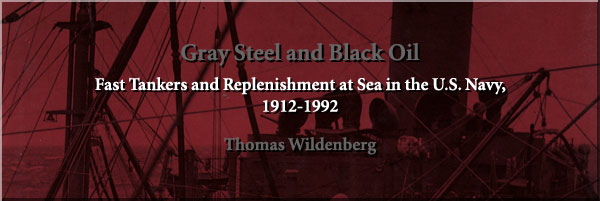
3
The Treaty Navy and the Problem of Refueling an
Overseas Expedition
At the conclusion of the First World War, the United States entered into a series of discussions on armaments culminating in the Washington Arms Limitations Conference of 1921--22. At the conclusion of these talks, the United States government agreed to sign a number of treaties limiting the size of the navy and suspending construction of new warships for a period of ten years. Among other things, an agreement was reached with Great Britain and Japan, the only great naval powers left after the Great War, to limit the tonnage of the capital ships in their respective navies by a ratio of 5:5:3, with Japan restricted to the smaller amount. Other "treaty limitations" adopted by the powers restricted the maximum displacement of battleships to 35,000 tons, prohibited guns larger than sixteen inches, and set limitations on carrier tonnage.
Japan, which had taken over Germany's possessions in the central
Pacific,1
was now perceived as a major threat to the United States and the country with which war was most likely. With this change, U.S. naval thinking shifted from the problems of the Atlantic to a strategy that would have to contend with the vast expanse of the Pacific Ocean. Accordingly, elements of the Atlantic and Pacific Fleets were soon merged into a single U.S. Fleet and moved to the West Coast.
Throughout the interwar period, contingency planning for war in the United States was based on a number of formal war plans developed by the Joint Army-Navy Board. The Joint Board, as it was frequently called, was composed of senior officers of the army and navy who were responsible for coordinating the war plans of both services. For the navy, these officers were the chief of naval operations, the assistant chief of naval operations, and the director of the War Plans Division.
The plans formulated by the Joint Board were called the "color plans" because of the color codes assigned to each nation: red for
--27--
Britain, black for Germany, orange for Japan, and so on. Since orange was the code for Japan, the plan developed in case of war with Japan was named War Plan ORANGE. "ORANGE" quickly became the centerpiece of the navy's strategy throughout the interwar period and was to greatly influence the tactics, weapons, and ship characteristics adopted to meet the needs of a war that was sure to be fought over immense distances between the forward bases projected for use in the Pacific.
By the summer of 1924, the Joint Board had reached agreement on a basic strategy for ORANGE designed for a rapid advance across the Pacific, which Edward S. Miller, in his authoritative study War Plan Orange, has dubbed the "Through Ticket."2
In the event of war with Japan, the main units of the U.S. Fleet would be dispatched to the Western Pacific where it was assumed the Asiatic Fleet would be fighting a holding action against the Japanese forces.3
Speed was an essential element of the plan if the Asiatic Fleet was to be rescued before the fall of the Philippines. Although the exact details of War Plan ORANGE were frequently modified and revised during the decade of the 1920s, its basic concept remained unchanged: major units of the fleet would be quickly formed into a fighting unit and sent to the Western Pacific. Upon mobilization, the main forces of the U.S. Fleet would be concentrated in Hawaiian waters, then dispatched across the Pacific to establish an advance base or bases from which offensive operations could be mounted against Japan. The planners assumed, with some certainty, that Pearl Harbor, the Hawaiian and Midway chains, and the inner Aleutian Islands would remain in American hands. Holding the Philippines, Wake, and Guam was more questionable.
Much of the planning for ORANGE concerned the buildup of sufficient fleet units and air support in these forward areas. In most versions of the plan, the logistic forces required to support the fleet were to follow in a supply "Train" (a corporate entity of the U.S. Fleet) made up of troop transports, cargo vessels, ammunition ships, oilers, hospital ships, and tugs. Even the need to supply floating dry docks was foreseen by the planners. The Train was scheduled to transport the expeditionary force and would carry all the replacement personnel and aircraft needed to establish the forward bases that were to be acquired to support fleet operations in the Western Pacific.
Although the number of ships assigned to the Train in the 1920s varied from plan to plan, the number of support vessels always exceeded two hundred ships of which at least one hundred were tankers (see table 2). The peacetime navy could never support such vast numbers of auxiliaries, so plans were contrived for the wholesale acquistion and conversion of large numbers of merchant ships in the
--28--
TABLE 2
War Plan ORANGE, Fleet Auxiliaries and Noncombatants Included in the Train
| |
Year |
| Ship types |
1922 |
1924 |
1925 |
| Fleet Auxiliaries |
26 |
18 |
20 |
| Tankers |
116 |
116 |
100 |
| Colliers |
27 |
32 |
20 |
| Transports |
12 |
32 |
99 |
| Hospital |
9 |
2 |
6 |
| Cargo, ammunition, tugs, and misc. |
106 |
22 |
128 |
| Total in Train |
296 |
222 |
373 |
SOURCE: Extracted from E. Miller, War Plan Orange, 128.
event of war.4
As for the fleet, the eighteen navy oilers built or acquired just after World War I were thought sufficient for its immediate needs.
By the late 1920s, the plans for ORANGE had evolved into an immense undertaking involving hundreds of ships, which would steam across the Pacific to an advance base to be quickly established in the Philippines.5
Hawaii was to be the jumping-off point for the fleet, which was to sortie from the islands at thirty-day intervals. The timetable for this elaborate scheme showed that it would take the battle force, the first wave to depart, twenty days to reach its objective at a projected speed of 10 knots--the fastest that could be maintained by all of the ships in the armada during the 4,800-mile cruise. Since none of the minor combatants or small auxiliaries scheduled to accompany the fleet had the required range to cross the Pacific without replenishment along the way, fueling enroute was an obvious necessity.6
Fortunately for the U.S. Navy, it had continued to develop this important concept throughout the 1920s.
Postwar Experiments in Fueling at Sea
After World War I, experiments in the application and development of fueling at sea were continued using navy oilers assigned to the Base Force. In October 1921, the fleet oiler Cuyama conducted fueling teste with the destroyer Hogan (DD-178), which was taken in tow by the tanker. The equipment used included two fixed-wire hawsers 1½ inches in diameter and 590 feet long. The operation was not considered a success, however, and recommendations were made for further testing using an automatic tension engine to provide the needed tautness in the towline. The plan contemplated the use of one slacked-distance hawser with two elevated hawsers for supporting the fuel lines, the
--29--
ends of all three leading to the drum of the tension winch. Adm. Edward W. Eberle, commander in chief of the Battle Fleet, recommended that at least one of the tankers operating with the fleet be fitted with a towing engine in order to test this concept. The Kanawha was designated for this purpose and the improved equipment installed at Mare Island in the fall of 1923. In the meantime, the Cuyama had conducted other tests using the riding-abeam method to fuel destroyers while under way.7
Early Tests of the Riding-abeam Method
In April 1923, the Cuyama had successfully fueled eight destroyers in pairs. "Steaming at comparatively slow speed in calm weather," the oiler was able to transfer fuel through separate 4-inch rubber hoses passed between the ships while the oiler steamed in company with one destroyer on each beam (see fig. 4).8
This was the first time that two ships had been simultaneously refueled from the same tanker while under way. The Cuyama continued to experiment with the riding-abeam, or "broadside," method, fueling the light cruiser Omaha (CL-4) in smooth seas on 11 January 1925. The following extract taken from the Omaha's log indicates how this operation was accomplished:
Meridian to 4:00 p.m.
Steaming as before alongside CUYAMA with riding line of two parts 10" manila, and bow and stern breast of 8" manila. CUYAMA speed 4 knots, own speed 1 knot on course 110° p.g.c. 110° true. Boilers #10, #11 and #12 in use. Receiving fuel oil over two 4" fuel lines. At 1:20 connected up third 4" fuel line. Average steam 250. Average Revolutions 19.9.
Signed H. F.
Newton
Lieutenant,
U.S. Navy9
The two vessels increased speed to 4 knots and continued refueling until 1600. The Omaha cast off at 1615 after receiving a total of 221,878 gallons of fuel oil. (Note the amount. Since fueling commenced at 1150 hours, the transfer rate was more than 55,000 gallons per hour.)
Although no difficulties were recorded, the Cuyama's skipper was concerned about the possible damage that could result from this type of operation, especially if it had been tried in rough weather. In his stated opinion, "fueling alongside ships larger than destroyers would be impractical in anything but calm sea since swells of any magnitude would result in damage to the tanker hull and rigging."10
His conclusions in this regard appear to have been taken at face value and remained unchallenged for fourteen years even though the flow rates
--30--
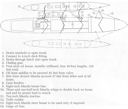 Fig. 4. Fueling two ships abreast--arrangement
demonstrated onboard the Cuyama in
the mid-1920s for fueling two destroyers at once (after an
original in the National Archives)
Fig. 4. Fueling two ships abreast--arrangement
demonstrated onboard the Cuyama in
the mid-1920s for fueling two destroyers at once (after an
original in the National Archives)
demonstrated during this operation would have fulfilled the at-sea fueling requirements of large capital ships.
The Development of the Over-the-Stern Method
Testing Kanawha's towing gear (as requested by Admiral Eberle) did not begin until December 1924, when the Kanawha transferred 29,186 gallons of fuel oil via the over-the-stern method to the Arizona in smooth seas.11
A second series of tests was conducted on 23 May 1925 to evaluate the performance of a new type of tension engine installed on the Kanawha. Once again, the Kanawha attempted to fuel the Arizona while both vessels were under way, but the exercise was discontinued after the fuel hose between the two ships ruptured.12
No attempt was made to reconnect the hose, since sufficient data had already been obtained concerning performance of the tension engine.
--31--
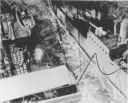 Cuyama (AO-3) fueling Sumner (DD-333) while under way circa 1925.
The fueling gear appears to have been jury-rigged by securing the
hose to the oiling boom. Note how close the ships are to one another
as they steam side by side separated by only 20 feet or so. This
type of operation could only be conducted in smooth seas as indicated
from the photograph. (Naval Historical Center)
Cuyama (AO-3) fueling Sumner (DD-333) while under way circa 1925.
The fueling gear appears to have been jury-rigged by securing the
hose to the oiling boom. Note how close the ships are to one another
as they steam side by side separated by only 20 feet or so. This
type of operation could only be conducted in smooth seas as indicated
from the photograph. (Naval Historical Center)
After reviewing the results of this second test, the Bureau of Construction and Repair requested that additional tests be made to determine the effects of adverse sea conditions on the performance of the special gear installed on Kanawha for over-the-stern fueling.13
Neither an exact description of this equipment nor its arrangement has survived, but the photographic evidence (see photograph on page 34) indicates that the new tension machine was placed on top of the deck house with special rigging to support the hose as it passed over the ship's stern. The new tension machine supplemented the regular towing engine mounted on the poop deck, which was used to adjust the towing line. The tension machine was intended to keep the fuel hose from dragging in the water. If this occurred, the cold seawater would
--32--

The saddle arrangement was used by Cuyama in the mid-1920s to support the fuel hose while fueling at sea.
(Author's collection)
--33--
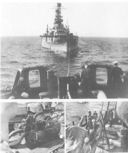 Fueling tests conducted between Kanawha and Arizona in the mid-1920s. (Top) Kanawha playing out towing line. (Lower left) The steam-powered tension engine was a special device installed on Kanawha so
that the fuel lines would not drag in the water while fueling astern.
(Lower right) The crew sets the steel tension line (Author's collection)
Fueling tests conducted between Kanawha and Arizona in the mid-1920s. (Top) Kanawha playing out towing line. (Lower left) The steam-powered tension engine was a special device installed on Kanawha so
that the fuel lines would not drag in the water while fueling astern.
(Lower right) The crew sets the steel tension line (Author's collection)
--34--
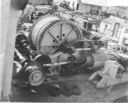
Fueling tests conducted between Kanawha and Arizona in the mid-1920s. (Top) Steam-powered towing engine located on the ship's stern.
(Bottom) Arizona is in tow while fuel is transferred from the Kanawha via the astern method.
Note how the steel tension wire keeps the fuel hose from dipping into the sea. (Author's collection)
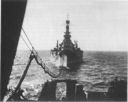
--35--
chill the heated fuel oil as it flowed between the ships, increasing the viscosity of the oil and making it more difficult to pump. From subsequent reports, it appears that the tension setup worked well in keeping the hose out of the water, for although the height of the hose varied (from just touching to fifteen feet above the surface), it was always kept above the sea.14
A third series of tests was conducted between the two vessels on 16-17 December 1925. This took place in the open sea off San Pedro, California, and was intended to test the towing gear's performance in rough seas.15
Unfortunately, the weather did not cooperate. The sea was so smooth that the potentially harmful effects of severe pitching could not be determined. It was important, though, to determine just how effective the astern method would be under less than ideal conditions.16
Thus, another series of tests was needed. These tests were not scheduled until the following year when Adm. R. H. Jackson, commander in chief Battle Fleet, directed the Kanawha and the Arizona to conduct further tests of Kanawha's gear "for fueling battleships at sea under more adverse conditions than obtained at the last test."17
The fourth and final fueling test between the two ships was eventually carried out on 31 October 1926 in sea conditions that were slightly rougher than in the previous tests.18
As a result, both ships were rolling and pitching more than on previous occasions. The gear on board the Kanawha functioned as expected, however, and the automatic feature of the tension engine was able to keep the fuel hose above the water for the entire four-hour pumping period.
Although the tests undertaken by the Kanawha clearly demonstrated that the specialized over-the-stern fueling equipment could be successfully employed to fuel large vessels in moderately rough weather, the quantity of oil that could be transferred was considered to be too small to warrant the expense of installing this setup on other oilers. Even under ideal conditions, the transfer rate was at best only about 16,000 gallons per hour. Admiral Jackson advised "that no other oiler be equipped with gear similar to that on the Kanawha unless provision is made for handling hose of larger size which will allow a materially greater delivery of oil to be made." In addition, he restated the previous recommendation that no change be made in the present "alongside" method of fueling destroyers and light craft as this method could be used "with greater dispatch in all weather than the astern method."19
Admiral Jackson's report must have been passed on to the chief of naval operations for it made its way into the hands of the director of war plans. The record indicates that at that time the War Plans Division was concerned with the short steaming radius of the battleships Nevada, Oklahoma, Arizona, Idaho, Pennsylvania, and Mississippi. In a report to the chief of naval operations dated 7 February 1927, the
-36---
director of war plans noted the lack of secure bases in the Pacific (the most likely theater of war) and the problem this would pose for the fleet. His views on refueling at sea were expressed as follows:
the development of fueling at sea gear is desirable not only for the shorter radius battleships but for other types larger than destroyers--including light cruisers, on which experience indicates the desirability of astern fueling in cases where fueling alongside is impossible or hazardous.
. . . in view of the present limited fuel capacity of some 6 battleships of the fleet, it is important from War Plan's point of view that fueling at sea be at the best practical speed in order that fleet movements may continue uninterrupted by fuel operations.20
The chief of naval operations forwarded the comments made by the director of war plans to the Bureau of Construction and Repair on 9 March.21
The bureau's response, written by Rear Adm. George H. Rock, acting chief, attempted to eliminate any further efforts toward the continued development of the over-the-stern method. Rear Admiral Rock began his argument by pointing out that the bureau knew of no towing practice, either military or commercial, which would permit vessels the size of battleships to be towed at the speeds (10-12 knots) requested by war plans. The tests conducted by the Kanawha had shown that the large quantity of steam needed to run the tension engine, fuel-oil pumps, and other necessary auxiliaries placed so great a demand on the ship's steam plant that the quantity of steam available to the engines was only sufficient to permit a speed of approximately 6 knots. If, as recommended by the commander in chief, a larger size hose was required for increasing the fueling rate above the 15,000 gallons per hour achieved by the Kanawha, even less steam would be available for the main engines and it was probable that the towing speed would be even less than the 6 knots achieved previously.22
As to the limited fuel capacity of the six older battleships, Rear Admiral Rock explained that plans to modernize the Nevada and the Oklahoma (already authorized by Congress) included an increase in emergency fuel capacity. The bureau also understood that the department intended to request authorization to modernize the other four battleships (the Arizona, Pennsylvania, Idaho, and Mississippi) within the next two years.23
Rear Admiral Rock concluded by requesting from Admiral Eberle, the chief of naval operations, a statement of policy with regard to fueling at sea. Admiral Eberle quickly resolved the issue. On 14 April 1927, he directed the Bureau of Construction and Repair to continue experiments in increasing the delivery rate of the astern method with the view of equipping all tankers with the machinery needed to accomplish this task once a satisfactory method had been devised (it never was).24
While work was to continue on the development of fueling
--37--
astern, Eberle also instructed the bureau to equip all tankers (other than those temporarily commissioned for the specific purpose of transporting oil only) with fueling-alongside gear at the time of their commissioning.25
Eberle, as we shall see shortly, was obviously concerned about the fleet's ability to refuel enroute to the Philippines. Nevertheless, further work on an effort to improve the performance of the fueling-astern gear originally installed on board Kanawha was suspended on 18 December 1929 when that ship was decommissioned for overhaul.26
Despite the fact that the Bureau of Construction and Repair intended to transfer this gear to the Neches, further development was curtailed due to a lack of funds.27
Although all work on oiling astern was not officially canceled until 1 April 1931, it is clear that the modernization program and the subsequent increase in battleship cruising range eliminated any need to further pursue this line of development.28
The foregoing is of particular interest not only because it provides technical insights into the problems of refueling at sea, but more so because it demonstrates the administrative workings within the Navy Department and the potential for political rivalry inherent in the bureau system. Rear Admiral Rock adroitly exploited his technical expertise to placate the director of war plans while obtaining the policy decision desired by his bureau. The author believes that the high level of technical competence and administrative excellence demonstrated by Admiral Rock was typical of those within the officer corps who had risen to high administrative position. To achieve such status, a naval officer had to prove his technical competency while exercising the political acumen needed for continued favor within the department. While promotion within the department appears to have been based on merit, the best billets (i.e., those that would lead to the greatest opportunities) were greatly influenced by the patronage and influence of those officers who were in a position to recommend or suggest appointments to the chief of the Bureau of Navigation, the chief of naval operations, or the secretary of the navy. Diplomacy and/ or the ability to cultivate friendships appears to have been an essential attribute of those officers who achieved flag rank.
The Problem of Fueling an Overseas Expedition
In retrospect, it is evident that the large steaming distances envisioned by the navy's war planners fostered and encouraged the Bureau of Construction and Repair's efforts to develop a workable method of fueling at sea. By the time the plan was completed in 1929, it included an elaborate schedule of refueling along the way, albeit the tactics of how to manage the operation had yet to be developed.29
Even if there were no possibility of an engagement enroute to the Philippines, which was quite possible, the planners realized that there might be days or weeks of operations before any base could be made secure enough to
--38--
TABLE 3
Vessels to Be Refueled during
Overseas Expedition, War Plan ORANGE, 1928-29
| Number |
|
Ship type |
| 68 |
|
Destroyers |
| 5 |
|
Light cruisers |
| 10 |
|
Mine layers |
| 20 |
|
Submarines |
| 10 |
|
Auxiliaries |
| 11 |
|
Fleet tugs |
| 6 |
|
Coast Guard cutters |
SOURCE: "The Problem of Refueling an Overseas Expedition," File S1-S68, SecNav SC-files,
RG 80, NA.
allow all ships to anchor and refuel. Refueling the short radius ships became so vital to the success of ORANGE, that the head of war plans, Rear Adm. Montgomery M. Taylor, considered the ability to fuel at sea "with speed and certainty [to be] of the highest importance."30
Navy planners included twenty-one tankers in the Train to provide fuel for the fleet, all but seven to be merchant types requisitioned by the navy once war was declared.31
To avoid having to slow down the entire expedition while refueling the smaller combatants, the planners intended to use the three fastest navy tankers as much as possible

The destroyer Perry takes fuel from Arizona while participating in
the fleet exercises of 1932.
(Kauffman Collection, Naval Historical Center)
-39---
 Brazos (AO-4) was the first of three Kanawha-class oilers completed by the Boston Navy Yard, in the early 1920s. Note the new location of the center island superstructure, the decrease in the number of centerline
masts, and the plethora of small booms for fueling and small boat
handling. Taken at Panama, January 1931. (National
Archives)
Brazos (AO-4) was the first of three Kanawha-class oilers completed by the Boston Navy Yard, in the early 1920s. Note the new location of the center island superstructure, the decrease in the number of centerline
masts, and the plethora of small booms for fueling and small boat
handling. Taken at Panama, January 1931. (National
Archives)
with the "lose-and-gain method." These ships were capable of making 14 knots, and would be able to rejoin the main body during the night, after refueling a number of small vessels during the day. The ability to slow down for fueling operations during the day and then sprint to catch up the the rest of the fleet was one advantage in having tankers designed from the keel up as naval auxiliaries. The antithesis occurred with the shipping board tankers taken into the navy (see appendix A) whose lack of speed was a real detriment. (As shall become evident in following chapters, this shortcoming would not be overlooked in the next generation of tankers.) To insure that all ships had enough fuel, war plans provided a detailed schedule showing which vessels (see table 3) were to be fueled on a daily basis. Battleships, heavy cruisers, and airplane carriers were excluded from the list since most of these had a range of up to 10,000 miles when steaming at 10 knots, the planned speed of advance.32
In its report on the problem of refueling at sea, war plans made a number of recommendations that were to have a major impact on the operational development of this important innovation in fleet logistics.
--40--
Of prime importance, according to war plans, was the need to make fueling under way a "routine peace time exercise, to be carried out at least once annually by each Navy tanker."33
Fueling Exercises in the 1930s
The need to fuel destroyers at sea was heightened by the experience gained during Fleet Problem IX conducted off the Pacific Coast of Panama during the last week of January 1929. During the attack phase of the exercise, destroyers accompanying the covering force of battleships assigned to the Black Fleet segment of the exercise ran so low on fuel that it was unable to rendezvous with the aircraft carrier Saratoga (CV-3) leaving her with only the light cruiser Omaha (CL-4) as escort. Then, as Saratoga was making her high-speed run-in for a surprise attack on the Panama Canal, the Omaha too began running short on fuel and had to slow down.34
Taking heed of this "lesson learned," Adm. William V. Pratt, the Battle Fleet commander, wisely recommended that "battleships and aircraft carriers should be equipped and trained for oiling at sea."35

Fleet Problem XIII. The crew of a destroyer takes in
the 10-inch towing line in preparation for fueling at sea.
(Author's collection)
--41--
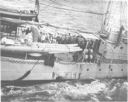
A pair of 4-inch fuel hoses are being hauled aboard
an unidentified destroyer during fueling-at-sea exercises
circa 1932.
(Author's collection)
Plans for fueling destroyers from the Tennessee (BB-43) and the West Virginia (BB-48) were soon drawn up by the Bureau of Construction and Repair with the suggestion that a test be conducted at sea "to determine definitely the gear required under actual operating conditions."36
Although documents describing the planned tests have not been located, it is clear from the photograph of the Perry taking fuel from the Arizona (see page 39) that fueling destroyers from battleships was readily accomplished.
Refueling destroyers at sea soon became a routine operation practiced on a frequent basis, though most often it was done by fleet oiler rather than a major combatant. The first of many such drills occurred in February 1931 when the Salinas (AO-19) conducted fueling at sea exercises while enroute from San Pedro to Balboa. She fueled the destroyers Barney (DD-149) and Hale (DD-133) in succession on the starboard side, and the destroyer Breckinridge (DD-148) on the port side while steaming at 3.5 knots. According to her executive officer,
--42--
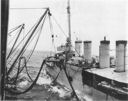
To increase the fuel transfer rate, Brazos (shown here) could deploy as many as four 4-inch hoses on one side.
(Author's collection)
"every thing worked perfectly." The Salinas delivered 106,000 gallons of fuel oil to the three destroyers during the operation, which lasted just over five hours. Fueling exercises were also included in Fleet Problems XIII and XIV carried out in 1932 and 1933 respectively. The Brazos (AO-4) participated in both problems using the broadside method to fuel a number of destroyers engaged in supporting the fleet. By this time, the procedures developed by the U.S. Navy for fueling destroyers at sea from oilers were so well established that the Brazos was able to simultaneously fuel two destroyers at once by deploying as many as seven 4-inch fuel oil hoses to speed the transfer to her precious cargo.37
In the meantime, the Puget Sound Navy Yard had developed a rigging plan for modifying the carriers Lexington (CV-2) and Saratoga so they could fuel destroyers alongside based on a concept successfully demonstrated during tests by the Saratoga and Tarbell (DD-142) in 1930.38
Scheduled exercises using this approach were subsequently
--43--
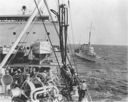
Sands (DD-243) comes alongside Neches (AO-5) to receive fuel while under way. (Naval Historical Center)
held in the fall of 1934 and again during Fleet Problem XVI with favorable results.39
Adm. Joseph M. Reeves considered the successful implementation of fueling destroyers at sea important enough to warrant its mention in his annual report as commander in chief of the U.S. Fleet for fiscal year 1935, although he made sure to qualify its usefulness by stating that it was still "attended by considerable danger of damage under any but ideal conditions."40
It appears that this attitude prevailed throughout the fleet during the mid-1930s and seems certainly to have contributed to the reluctance to develop a better means of refueling large vessels under way.
--44--
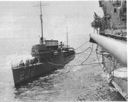 Saratoga (CV-3) is shown fueling
destroyers at sea in the early 1930s. Humphreys (DD-236) is taking fuel from a
small boom mounted aft of Saratoga's 8-inch turret. Note the breast line and what appears to be a
second fuel hose yet to be taken aboard. (National Archives)
Saratoga (CV-3) is shown fueling
destroyers at sea in the early 1930s. Humphreys (DD-236) is taking fuel from a
small boom mounted aft of Saratoga's 8-inch turret. Note the breast line and what appears to be a
second fuel hose yet to be taken aboard. (National Archives)
--45--
Contents
Previous Chapter (2) **
Next Chapter (4)













